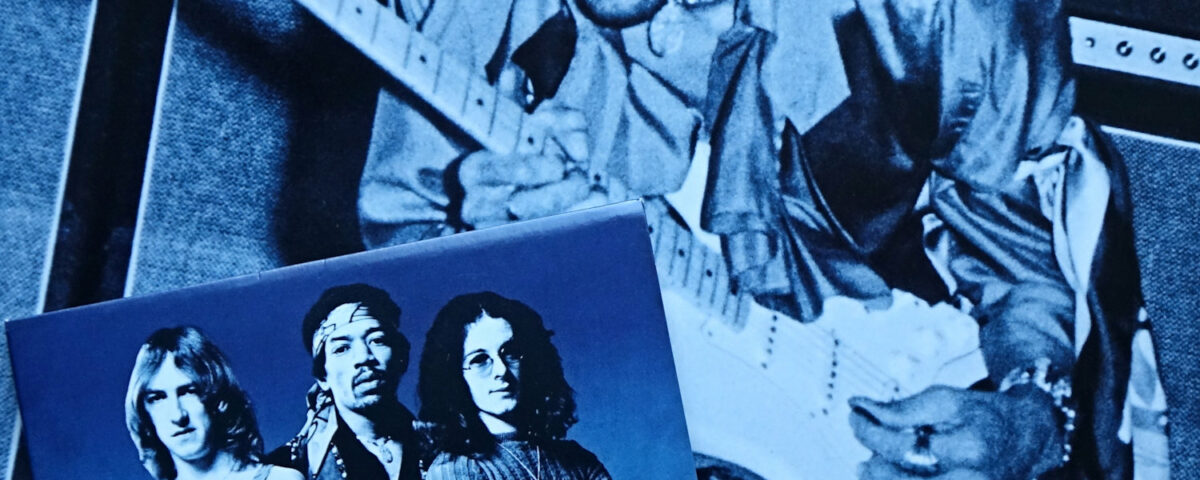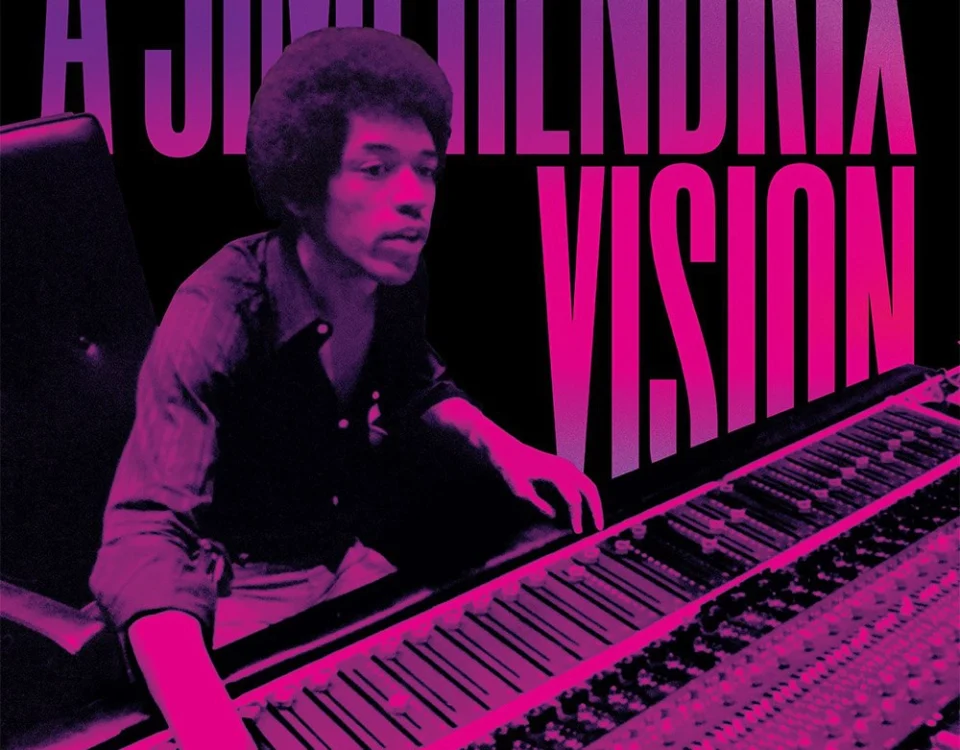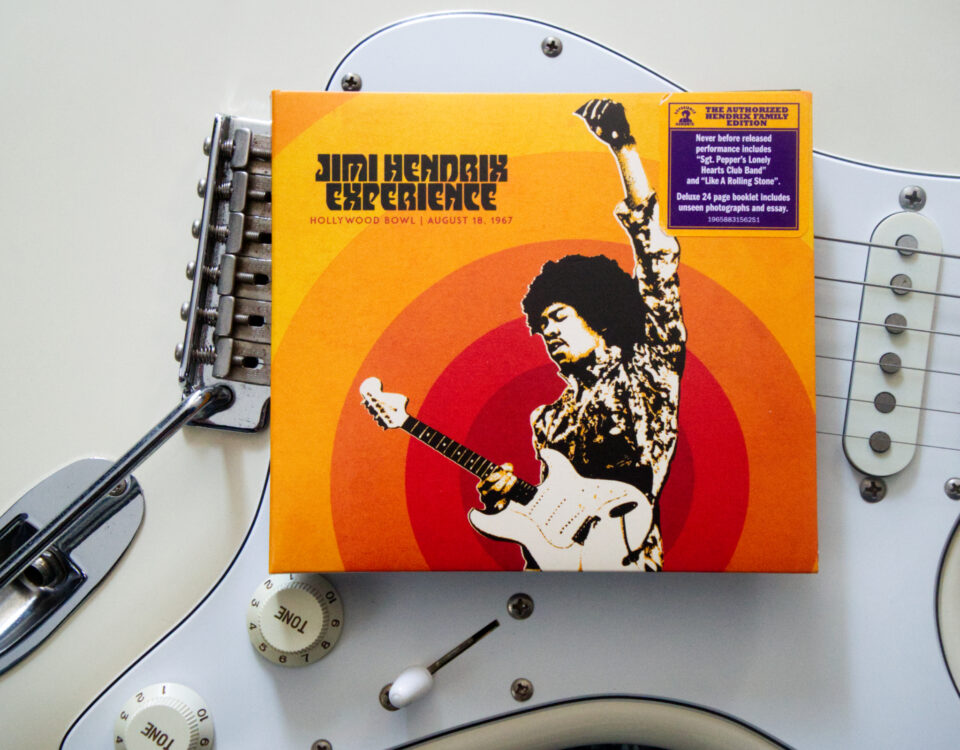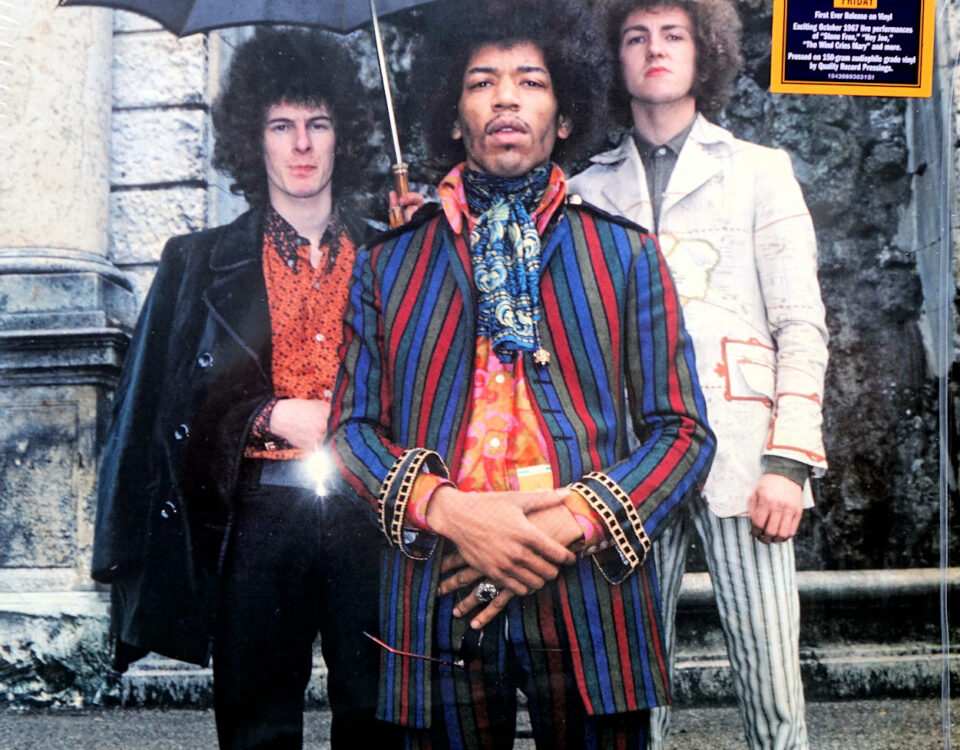CHAPTER TWENTY-SIX: YET ANOTHER SLIGHT RETURN
It is getting toward late November, 2022, with December looming. Also looming is the 80th birthday of Jimi Hendrix, born November 27, 1942. One might hope for a truly spectacular release in celebration of such a milestone anniversary, and one would be disappointed.
Instead of a stunning compilation consisting of unheard treasures from the depths of the Experience Hendrix vaults, what’s actually on offer currently is a far more modest title with a very familiar air.
Then again, anniversaries don’t seem to be picked up on the Experience Hendrix radar screen. The announcement of the impending release of Both Sides of the Sky missed Jimi’s 75th birthday by nine days. Perhaps calendars are in short supply out in Seattle.
As you will no doubt recall, that 2017 announcement crowed that Both Sides of the Sky was the concluding piece of a trilogy that had begun with 2010’s Valleys of Neptune and then featured 2013’s People, Hell and Angels as a second chapter. The revelation that there had long been a planned trilogy concept was greeted with skepticism. That emotion yielded to discomfort when the cover of Both Sides of the Sky presented a photo of Jimi so drastically retouched that the portrait resembled a young man who sort of looked like Jimi Hendrix rather than an image of Hendrix himself.
Ah, but that was then and this is now.
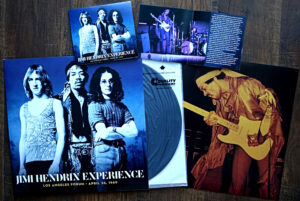
The CD and vinyl versions of the November 2022 live release Jimi Hendrix Experience: Los Angeles Forum April 26, 1969. (Photo: Modern Listener Archives)
So, onward with a new free chapter of Modern Listener Guide: Jimi Hendrix, focusing on Jimi Hendrix Experience: Los Angeles Forum – April 26, 1969. That’s the title on the cover of the CD and double-LP releases, but we’ll save a few thousand keystrokes by henceforth utilizing the title listed on the spine of the packaging, the more economical Los Angeles Forum. Both the CD and vinyl versions were released on November 18.
As you may have already noticed, these free chapters covering every new Hendrix release since the publication of Modern Listener Guide: Jimi Hendrix in 2018 are less formal and more conversational than the book’s published chapters. How different are they? Well, you can read a sample publication chapter on the website at www.modernlistenerpublishing.com. And a batch of paragraphs straight from the text will soon be making an appearance in this free chapter.
Wait, why the recycling of paragraphs? That’s because to a great degree Los Angeles Forum is itself a recycling.
Way back in 1990 – and actually on Jimi Hendrix’s November 27 birthday – a four-CD set titled Lifelines was released by the then-in-power controller of the Jimi Hendrix archives, Alan Douglas. Three of the discs were based on an audio documentary about Jimi’s life and career that had been broadcast as Live & Unreleased: The Radio Show. The fourth CD? The April 26, 1969, Los Angeles Forum concert performed by the Jimi Hendrix Experience. Now, more than three decades since its 1990 release, this performance has cycled around into the marketplace yet again.
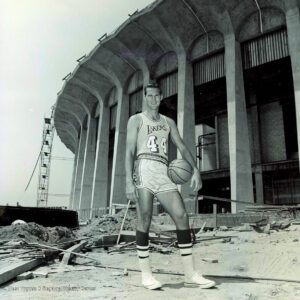
Jerry West of the Los Angeles Lakers stands outside the Forum, under construction in 1967, well over a year before the Jimi Hendrix Experience would perform in the building. Jimi was apparently unavailable for the photo call on this day. (Photo: West Virginia University)
We must make one side note about the Lifelines Forum release. As a man whose career overseeing the Hendrix realm is characterized by many curious decisions, Douglas decided to excise “Foxy Lady” from the Forum concert running order. He made the same decision with the same song a year later in 1991 when the May 24, 1969, San Diego concert was (mostly) presented on the Stages box set. Perhaps Douglas just didn’t like “Foxy Lady,” though curiously the Forum version did appear as an extra track a year before Lifelines on the 1989 CD release of The Jimi Hendrix Concerts. As I said, curious…
Regardless, right off the bat, I will state that the new 2022 Los Angeles Forum incarnation of this show recorded more than 50 years ago is the superior release.
But first, since Modern Listener Guide: Jimi Hendrix is squarely focused on Jimi’s approaches to creating his music, let’s take an in-depth look at this performance, as analyzed in the pages of the book. Set the Way Back Machine to April 26, 1969, in the cavernous, nearly 20,000-seat Los Angeles Forum…
********************
The band is brought to the stage with an enthusiastic introduction: “Let’s make some noise – the Hendrix Experience!” It immediately becomes clear this huge crowd requires little encouragement to make a racket.
A very long and meandering “Tax Free” follows, Jimi and the Experience getting a feel for the stage, listening to how their amplification is responding this evening. The recording – arranged by Mike Jeffery and engineered by Eddie Kramer for another potential live album – sounds well-balanced. In the stereo mix Noel Redding’s bass is prominent in the right channel, Jimi’s guitar inhabits the center, and Mitch Mitchell’s drums pan from the center to the left.
“Foxy Lady” – the second song of the concert – is the only track Douglas omitted from The L.A. Forum Concert, so the program moves on to what Jimi refers to as an “American soul” song, the blues of “Red House.” It’s a disconnected version, not as focused as usual; Hendrix was likely distracted by audience attempts to rush the stage. In response to that behavior, police and security staff mill about in an attempt to maintain crowd control.
“Spanish Castle Magic” takes some unusual turns, with Jimi eventually bringing the song down to a hush with soft octave runs. From there he enters an extended solo section, the guitarist unaccompanied for the moment by Noel and Mitch. Hendrix stands alone before 17,000 people, alternating between single note runs and chordal explorations – and even tossing in some of the then-popular guitar instrumental “Classical Gas,” written by Mason Williams. Jimi abruptly returns to “Spanish Castle Magic,” drawing the rhythm section back in to drive the song to its traditional conclusion.
“Traditional” almost describes the opening passages of “The Star Spangled Banner,” played so softly it sounds like Jimi’s merely using the phrases to check his Stratocaster’s tuning.
“Here’s a song we were all brainwashed with,” he suddenly announces. “Remember this oldie but goodie?”
By anthem’s end, Hendrix has unleashed his full array of guitar effects through the amplification, dive-bombing his way into the tritone introductory notes of “Purple Haze.” The song has a frantic solo, drifting its way out of key before concluding with a series of variations on the familiar main riff, discernible amidst swells of feedback and harsh atonal scraping.
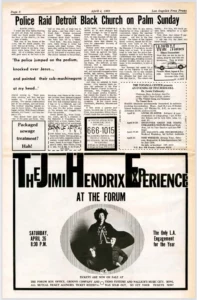
As noted in the “Los Angeles Free Press” in early April 1969, you could dial 666-1015 to pay for phone service “for people under 25” – or you could spend that money on tickets for the Jimi Hendrix Experience playing at the Forum in just over three weeks. (Modern Listener Archives)
Between songs, the sounds of an audience that is not settling down can be heard. This vocal, noisy assembly is clearly in a confrontational mood. By the end of “Purple Haze,” Hendrix has had enough of the disorder.
“Let’s just relax, sit down, and let’s get the rest of this thing over with,” Jimi says in resigned aggravation.
Perhaps appropriately “I Don’t Live Today” follows that comment. The song lumbers into life, the band stumbling through a ragged first section, but coming together to rally with an energetic back half. Compared to other concert renditions of this song in this era, this is a short pass; Hendrix even skips his customary quote from The Beatles’ “Tomorrow Never Knows.”
At this point, based on Jimi’s comments, there are members of the police force on stage with the band.
“Let’s act like we’ve got some sense,” Jimi requests. “Sit down and dig the sounds and don’t start any more trouble because there’s enough already, alright?”
The Experience try to refocus the crowd by surging into “Voodoo Child (Slight Return),” but, coming out of the solo, things take a technical turn for the worse on the multitrack recording. With the band volume dropped to set up a sprint to the finish under Hendrix’s lyrical apology – “I didn’t mean to take up all your sweet time…” – there are suddenly almost no vocals. Jimi’s voice can just barely be made out, picked up from the audience’s PA feed by the recording microphones on the stage. The main vocal recording signal is silent.
Having originally announced his intention to leave the stage after “Voodoo Child (Slight Return),” Hendrix instead leads the Experience directly into four instrumental minutes of “Sunshine of Your Love,” perhaps a gesture to counter some of the bad vibes settling over this concert. He then reanimates “Voodoo Child (Slight Return),” this time as a compact instrumental, eventually unleashing blazing alternate picking throughout a lengthy chromatic ascension. It all ends with long, feedback-cloaked notes as Hendrix brings this chaotic show to its final climax.
Though The L.A. Forum Concert documents a fairly interesting show, you won’t encounter the Experience at the very top of their game playing for a polite audience; this recording captures one of the unruly rock-and-roll-combat-duty shows of the 1969 tour. Mike Jeffery may have had a live Jimi Hendrix Experience album in mind, but all of the disruptions, occasionally dispirited musical moments, and nagging technical problems made it obvious that this Los Angeles concert would not be the ultimate source.
********************
Listening to this concert again on the new Los Angeles Forum, were my impressions still the same several years down the line?
I do still feel that the Los Angeles gig is indeed “a fairly interesting show,” yet one that does not rise to the rare air inhabited by the magical San Diego performance the Experience conjured up four weeks later. Still, having seen the Experience myself two weeks before the Los Angeles date, I am always excited to hear shows from this late period in the Jimi Hendrix Experience’s existence. Songs that had wham-bam, in-concert presentations for over two years were now extended by Jimi into something else entirely. And if the explorations didn’t always lead to musical nirvana, they were at least fascinating sonic excursions.
And speaking of explorations, the set-opening “Tax Free” is just that. Played live by the Experience less than two-dozen times, this instrumental generally clocked in between seven to ten minutes. Here in Los Angeles the trio approached the 15 minute mark, claiming the runner-up position in the “Tax Free” duration contest (Your winner: played at the second show on October 11, 1968, at Winterland, the song running just over 20 minutes.)
“Foxy Lady” followed, and it’s good to have the track restored to its proper place in the running order on Los Angeles Forum. The liner notes to the Lifelines edition of this show brush off the absence of the song by pointing to its presence on the CD versions of The Jimi Hendrix Concerts, but it was missed as a high-energy transition from the jamming on “Tax Free” to the blues of “Red House.”
I’m a bit more enthralled with this take of “Red House” than when I reviewed it for Modern Listener Guide: Jimi Hendrix, but it’s still just a template for the format of the fully-realized San Diego version Jimi would craft the following month.
As I noted in the book, Jimi seems to get more aggravated by the antics of the massive audience as the show progresses, and I’d forgotten about his improvised lyrical nods to the situation in “Purple Haze”: “Excuse me while I kiss that policeman there,” and, “Whatever it is, that headache put a spell on me!”
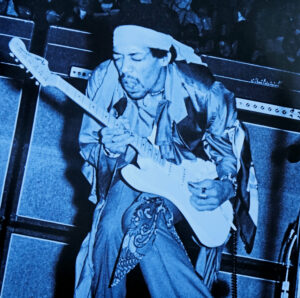
In one of author Frank Moriarty’s favorite photos of Jimi Hendrix, the guitarist is mid-set at the Forum, his Stratocaster drawing him inexorably into the tight embrace of musical creation. This photograph by Tom Nyerges is a cropped-and-tinted highlight, seen here as it appears in the booklet accompanying Los Angeles Forum. (Original photo: Tom Nyerges/Authentic Hendrix LLC)
It is fun to try to put yourself in the performance shoes of the Experience as the show roams toward its conclusion. Seven minutes into “Voodoo Child (Slight Return)” Mitch Mitchell and Noel Redding appear to be earnestly trying to bring the song to its typical ending. But as Noel carries on Mitch suddenly spies the opportunity for a drum solo and plows ahead.
The uncharted territory provides a path for Jimi to regain control by launching into a cover of Cream’s “Sunshine of Your Love,” mostly a jam when played by the Experience that usually ended up in its own wandering section. Jimi’s relying on percussive scrapes, Noel offers long drone bass notes, and Mitch bashes onward.
To escape the meandering, Jimi regroups with a quick tour of “Outside Woman Blues,” continuing the nod to Cream, but can’t help reverting to “Sunshine of Your Love.”
The exit from that point is a somewhat awkward segue all the way back to the very opening of “Voodoo Child (Slight Return).” Realizing he’s just relaunched the entire song the Experience had played only minutes ago, Jimi steps to the mic to offer “Thank you very much!” He briefly jams as Noel and Mitch settle into the ending riff they’d tried to bring to fruition ten minutes earlier. This time it works, Jimi solo-noting this musical trip to an end on high-pitched feedback.
Comparing the audio presentation of Los Angeles Forum to Lifelines yields more subtleties than it does drastic differences. Experience Hendrix engineer Eddie Kramer has, in the past, tended to offer polite and tidy mixes of Jimi Hendrix live in concert. On Los Angeles Forum the soundscape is agreeable scruffier and aggressive, though Mitch’s drums seem slightly distant. But that’s not to dismiss Mark Linett’s mix on Lifelines (erroneously credited to “Linnett”). As with his mixes on Winterland material and other concert projects before Experience Hendrix came into existence, Linett employs the slightly-fuzzy treble overdrive of Noel Redding’s bass amps to give his Experience mixes a very lively “band on stage” feel. Since working under the Alan Douglas regime, Linett has gone on to play a role much like Kramer’s with Experience Hendrix as the studio guru of the Beach Boys catalog. Linett’s resume ranges from Frank Zappa to Los Lobos, and his own studio, opened in 1990, has hosted artists ranging from Jerry Lee Lewis to Elton John.
Aside from the aural variations between the two releases, there are minor content discrepancies between the raw source recordings of the show and what has been released in the past and in 2022.
For example, a few seconds near the four-minute mark of “Spanish Castle Magic” as heard on Lifelines have been edited out by Eddie Kramer on Los Angeles Forum. Perhaps to make up for it, later in the song nearly a minute of solo guitar chopped out of the Lifelines version has been restored by Kramer.
And, in “Voodoo Child (Slight Return),” as it winds its way toward the diversion of “Sunshine of Your Love,” Kramer – perhaps relying on an audience recording of the show – has painstakingly restored some of Jimi’s adlibbed words to the crowd which Douglas had simply allowed to remain inaudible in his release.
This last creative decision makes perfect sense, but the adding and subtracting of brief portions of songs makes far less sense – though we’ve witnessed it time and again over the years. Such minor tweaking may not really change the enjoyment level of these releases overall, but modern listeners are left wondering: why do it at all?
Moving on to the aesthetics of Los Angeles Forum, the sounds are presented in standard size CD wallet and LP packaging. The CD has one pocket on the left containing the booklet, with the typical plastic tray glued in on the right. The LP is, of course, double-pocket for the two albums, with the full-size booklet tucked into the lefthand pocket.
The artwork is essentially the same across the packaging of the two listening options, with the front and back cover image portraits taken by Ed Thrasher, selected from what was likely one of the last formal photo sessions of the original Jimi Hendrix Experience.
The booklets are not flashy but are very effective, especially the full 12”-square publication in the vinyl album packaging. As is the norm with Experience Hendrix projects, SMAY Vision has handled the overall design. But unlike past efforts, the photographic images are uncluttered and let the action depicted speak for itself. Tom Nyerges’ images taken at the Forum that night make up the bulk of the photos reproduced. Despite his apparent reliance on flash photography – and some tinting applied to his black-and-white images – they provide a great look at Jimi Hendrix on this long ago night. As is often the case, in all of the photos used in the packaging aside from the cover shots Noel Redding and Mitch Mitchell are essentially photographic afterthoughts.
The booklets are populated with liner notes from ZZ Top’s Billy F. Gibbons and Los Angeles writer Randy Lewis.
The content provided by Lewis is factually accurate if not revelatory. Don’t expect to encounter anything previously unknown in these standard-issue notes.
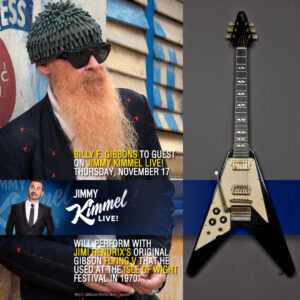
As part of the publicity for Los Angeles Forum, Experience Hendrix had the Gibson Flying V Jimi used at the Isle of Wight festival and elsewhere throughout 1970 flown to Los Angeles to be played by Billy Gibbons on ABC’s “Jimmy Kimmel Live!” Sadly, it was hardly worth the bother as Gibbons’ presence amounted to little more than a series of “blink and you’ll miss it” moments. (Modern Listener Archives)
Gibbons’ effort is a bit more remarkable, and not necessarily in a good way. Long known as a teller of tall tales and never one to let facts get in the way of a good story, Gibbons’ essay reads like his band The Moving Sidewalks opened for Hendrix in Texas, they became good friends, Gibbons and company then went on to see the Experience in Phoenix, and followed that up with their presence at the Los Angeles Forum gig. Which presents something of a timeline problem. The Moving Sidewalks opened for the Experience in February 1968. The Experience did not play in Phoenix until September 1968. And the Forum gig was April 1969. It must have been a very slow drive from Texas to California.
So, what does the future hold for upcoming Jimi Hendrix releases, which continue to appear at a glacial pace? We know a large box set covering Jimi’s work at Electric Lady Studios in 1970 is lurking down the road.
But what of live concerts? Have we truly reached the point where the only option with live material is repackaging previously released performances?
I certainly doubt that to be true. But there’s no arguing that Los Angeles Forum is a fine release. So, if we are to continue down this familiar road, then there are two obvious, essential concerts worthy of full curation – one which could fit in a modest package like Los Angeles Forum, the other demanding a box set effort. The first is the aforementioned May 24, 1969, show in San Diego, one that to date has seen its songs scattered hither and yon across multiple releases. And speaking of scattered, the other performance worthy of complete documentation is Berkeley, recorded on May 30, 1970. Why this one has not been done properly is a confounding mystery, but it’s time to correct that glaring oversight with a box set presenting the afternoon soundcheck/rehearsals and both concerts performed that evening.
Is it too much to ask to make this happen?
Postscript: To those who might logically point to the existence of 2003’s Live at Berkely release of the May 30, 1970, second show as an impediment to the creation of a complete Berkeley box set, I would remind you that 2016’s Machine Gun: The Fillmore East First Show was included in its entirety three years later in 2019’s Songs for Groovy Children: The Fillmore East Concerts box set. Just saying…

